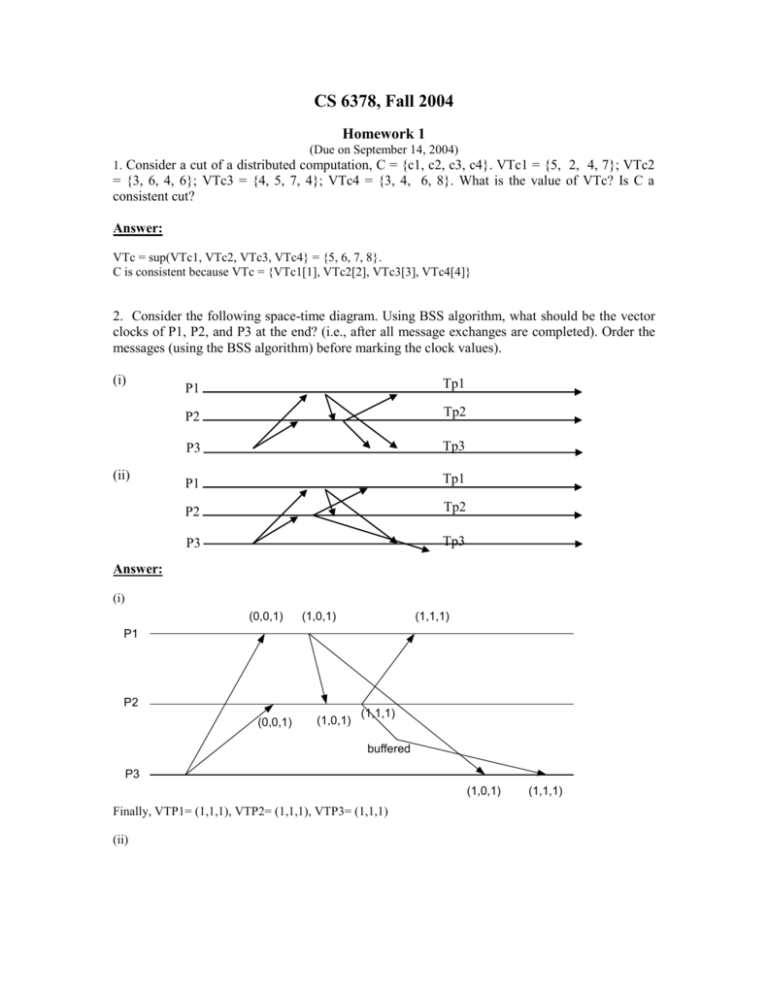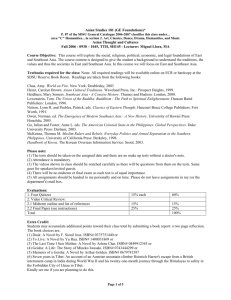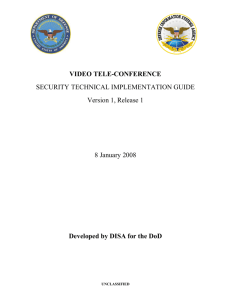hw1-sol
advertisement

CS 6378, Fall 2004
Homework 1
(Due on September 14, 2004)
1. Consider a cut of a distributed computation, C = {c1, c2, c3, c4}. VTc1 = {5, 2, 4, 7}; VTc2
= {3, 6, 4, 6}; VTc3 = {4, 5, 7, 4}; VTc4 = {3, 4, 6, 8}. What is the value of VTc? Is C a
consistent cut?
Answer:
VTc = sup(VTc1, VTc2, VTc3, VTc4} = {5, 6, 7, 8}.
C is consistent because VTc = {VTc1[1], VTc2[2], VTc3[3], VTc4[4]}
2. Consider the following space-time diagram. Using BSS algorithm, what should be the vector
clocks of P1, P2, and P3 at the end? (i.e., after all message exchanges are completed). Order the
messages (using the BSS algorithm) before marking the clock values).
(i)
(ii)
P1
Tp1
P2
Tp2
P3
Tp3
P1
Tp1
P2
Tp2
P3
Tp3
Answer:
(i)
(0,0,1)
(1,0,1)
(1,1,1)
P1
P2
(0,0,1)
(1,0,1)
(1,1,1)
buffered
P3
(1,0,1)
Finally, VTP1= (1,1,1), VTP2= (1,1,1), VTP3= (1,1,1)
(ii)
(1,1,1)
(0,0,1)
(1,0,1)
(1,1,1)
P1
(0,0,1)
P2
(0,1,1)
(1,1,1)
P3
(1,0,1)
(1,1,1)
Finally, VTP1= (1,1,1), VTP2= (1,1,1), VTP3= (1,1,1)
3. If each process uses a different value for d in Eqs. 5.1, 5.2, and 5.3, will the logical clocks and
vector clocks schemes satisfy the total order relation => and Eq. 5.5?
Answer:
(1) Logical clock does not satisfy 5.5 because if C(a)<C(b), then a->b is not necessarily true. No matter
what d is chosen. (see pp. 103 in textbook)
(2) Using a different value of d in Eqs. 5.1, 5.2, and 5.3 does not affect the property of vector clocks. So,
equation 5.5 still holds.
4. In the SES protocol for causal ordering of messages, when can a pair (s, t) be deleted from the
vector maintained at a site?
Answer:
When a message M from site S is delivered, if t < Tm (message time stamp), then (S,t) can be deleted since
the local time on S is already greater than Tm.
5. Consider the causal message ordering algorithms: BSS (Birman-Schiper-Stephenson),
“original” SES (Schiper-Eggli-Sandoz), and “modified” SES. What type of message time stamps
do they use (vector of clock values OR vector of sequence numbers)? Why? (Proper reason is a
must to get credit).
Answer:
BSS: vector of sequence numbers. Reason: receiver has to figure out whether it has
received all the senders’ messages. Receive events are not counted as part of the message
vector.
“Original” SES: vector of clock values. Reason: receiver has to count the receive events
also to know whether the earlier message indicated in the dependency information has
already been received.
“Modified” SES: vector of sequence numbers. Reason: the matrix identifies the sender
and receiver uniquely, so it is sufficient to count the “sent” messages (receive events are
not counted)
6. We saw in the class that the following is true for Cuts in a distributed system. A Cut is a
consistent cut if and only if VTc[1] = VTc1[1], VTc[2] = VTc2[2],… , VTc[n] = VTcn[n]. Can
you prove/explain why this is true?
(5 Marks)
Answer:
By definition, VTc[1] = max(VTc1[1], VTc2[1], …, VTcn[1]). If VTc[1] = VTc1[1], then
VTc1[1] >= VTc2[1],…,VTcn[1]. This means the cut event C1 includes all the sent messages by
the process P1 that have been recorded/marked as having been received by other processes
P2…Pn. Hence, the cut event C1 leads to consistency. Let us assume that VTc[1] < VTc1[1].
This means some other process has recorded a receive event from 1 and 1 has NOT recorded that
event => the cut is not consistent. However, we started with the fact that the cut is consistent. So
VTc[1] < VTc1[1] is NOT true => VTc1 = VTc1[1].
Similar arguments hold for VTc[2] .. VTc[n].
7. Consider a distributed application developed using Ada. The application has 1 Remote
Procedure Call. However, at run-time, the application has 10 instances of (the same) RPC server
running actively. (The RPC server was instantiated 10 times during run-time).
The system administrator wants to distribute clients’ RPC requests among these 10 server
instances so that their “load” can be approximately uniform. (i.e., the number of clients handled
by different RPC server instances is nearly same). Suggest techniques to the distributed system
administrator to achieve this.
(5 Marks)
Answer:
Use the binding/name server. For each client, bind to different server instances. Perhaps in
around-robin manner to distribute the load.







